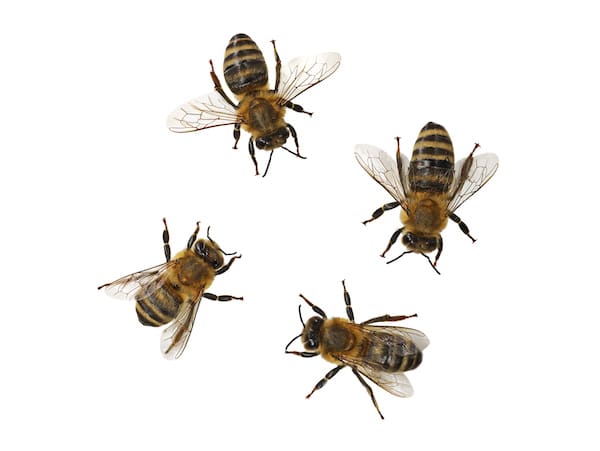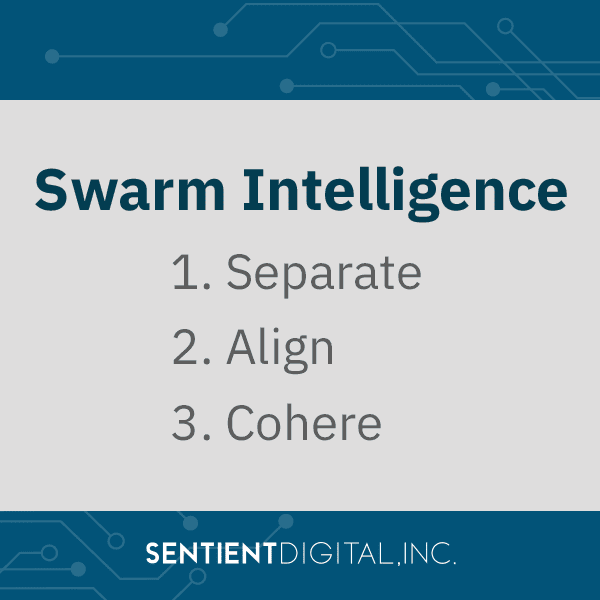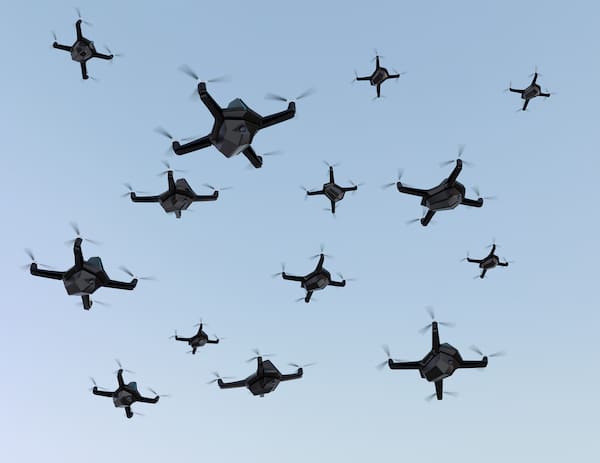A critical element of modern warfare, a military drone swarm can efficiently carry out missions while minimizing the danger to military personnel. Sentient Digital develops technology situations that support the warfighter, including unmanned systems, such as drones, that play a key role in battle and beyond. An important aspect of drone warfare is an understanding of the concept of swarm intelligence.
Swarm intelligence refers to the collective behavior observed in decentralized, self-organized systems. In the context of unmanned technologies like drones or robots, it deals with large numbers of simple agents that together accomplish complex tasks. Each of the agents follows simple rules but through their interactions, the swarm exhibits emergent intelligence beyond the abilities of the individual parts. Potential applications include surveillance and combat. Drone swarms take inspiration from social insects like ants and bees, leveraging swarm intelligence to create a powerful collective entity out of many simple agents.
Our Artificial Intelligence Research Scientist, Gene Locklear, has been leading a team to develop Ultron Emergent, a technology to facilitate the use of swarm intelligence to power drone swarms for military applications. Here Locklear explains how the technology works and how it can serve our military clients’ objectives.
BACKGROUND ON DRONES
Unmanned systems, often referred to as drones, are those systems that do not require the direct physical involvement of humans to operate. Humans control these systems remotely, such as by piloting a drone from a remote location, but the drones also contain artificial intelligence that allows them to essentially make decisions on their own as well. While drones have uses in civilian life as well, the military has many purposes for drones, including reconnaissance and surveillance. Drones can exceed their individual capabilities when combined in a swarm. A military drone swarm allows the drones to work in concert to achieve a goal, but each individual member of the swarm can separately determine and take whatever course of action facilitates the overall goal.
Unmanned vehicles can be an asset for the U.S. military, helping to keep military personnel out of harm’s way. However, they also represent a threat when utilized by our enemies. Recently, a drone attack on a base in Jordan resulted in the death of three U.S. soldiers, as well as injuring 40 people. In March 2023, a U.S. military contractor died and six people were injured in an attack by an unmanned aerial vehicle (UAV) on a base in Syria. This was the damage caused by a single UAV, and as this article will explain, a group of drones can exhibit swarm intelligence to become even more dangerous. It is critical for the U.S. military to understand the threat posed by a combat drone swarm and counteract it, while also leveraging drone swarms to further national defense objectives.
WHAT IS SWARM INTELLIGENCE?
Swarm intelligence is the principle that a group of simple intelligences operating in concert can operate as a single, collective intelligence with superior capabilities to any of the individuals. Locklear defines swarm intelligence as the idea of a decentralized “brain” where there is no single leader or decision maker, and all the required tasks are accomplished by the overall collective behavior of the individuals. Swarm intelligence is a type of emergent property, a concept in biology in which the interactions of individual parts of a system acting together produce an overall capability that exceeds that of the individuals. Essentially, swarm intelligence is a situation in which the whole is more than the sum of its parts. Examples of swarm intelligence exist in nature, in formations of migratory birds and in swarms of insects, from which swarm intelligence derives its name.
Swarm intelligence as observed in nature refers to the emergent collective behaviors that arise from decentralized coordination between organisms. Essentially, this means that when each member of a swarm individually follows local rules, the combined action of these members creates complex and “intelligent” group behaviors. A common example of this, discussed in more detail below, is flocking behavior in birds. A “V” formation of geese is made up of individual birds who each follow simple rules to stay in formation. Such self-organized and adaptive group behaviors can accomplish things together that would be impossible for individuals on their own, which, when applied to the military context, is a key benefit of swarms of drones beyond the effectiveness of individual drones.

Locklear further explains swarm intelligence is usually applied to systems where the individuals composing the system have very limited ability to perceive their environment or accomplish needed tasks alone. The behavior of bees provides a useful metaphor for understanding how military drone swarm intelligence works. The drones are like the individual bees (incidentally, also known as drones) that complete their tasks such as locating a food source or a new place to live together more efficiently as a collective whole. However, he cautions that in this case there is no “queen bee;” no individual drone outranks the others in the sense of command or decision-making ability. Instead, a bee can use what scientists term a “dance” to communicate the goodness of a location with resources to the rest of the hive, and the swarm collectively converges on that location. No one bee instructs the swarm to move; the swarm simply moves together, thus the swarm itself behaves in a way that simulates intelligence.
HOW SWARM INTELLIGENCE WORKS IN NATURE
How does the entire swarm seem to operate with one mind, but also allow for taking individual actions? Artificial intelligence researchers have used computer modeling to study the movements of swarms such as schools of fish or flocks of birds. They have determined that each member of the swarm adheres to three basic tenets: 1. Separate (stay a certain distance apart); 2. Align (move towards the destination); and 3. Cohere (try to stay together). By following these rules, the birds or fish can move together in formation, while also moving individually. For example, one bird in the swarm can move to dodge an obstacle that is only in that bird’s way, and then return to formation. The entire swarm does not have to move to make this happen and there is no leader of the swarm telling it how to move. By each individual focusing on one goal and staying within the bounds of the three rules, the collective intelligence moves toward the goal.

HOW CAN A MILITARY DRONE SWARM USE SWARM INTELLIGENCE IN BATTLE?
Applying the principles of swarm intelligence learned in nature to the military context means that a drone operator does not have to precisely control every movement or every drone within a swarm. Instead, the drone operator can send the swarm where it needs to be, and then the swarm intelligence primarily takes over to get the job done.
Locklear stresses that the most important aspect of swarm intelligence is the adaptability of the individuals in the system, to be assigned any required task as the need for that task increases in priority. Mission-critical operations can be performed by the drone most able to perform them at a given moment, rather than any hierarchy within the swarm dictating which drone should do so. Additionally, Locklear points out that swarm intelligence plays a major role in “military swarming” which is the military tactic of overwhelming the enemy by saturating that enemy’s defenses.
Drone warfare is shaping up to be the way the United States, as well as other countries, will wage war in the future. The United States was one of the pioneers in drone warfare, and particularly used unmanned aerial vehicles in Afghanistan and Iraq. However, in more recent years China, Turkey, and Iran have developed advanced drone programs. As an example of modern warfare using unmanned vehicles, Locklear mentions that drones have already played a significant role in the ongoing conflict in Ukraine, while also noting that, until recently, Russia has not spent as much effort on drone systems but has spent much more on anti-drone systems. As modern warfare evolves, it is likely that drones and drone swarms will continue to grow in importance, with major world powers increasing their use and developing ever more sophisticated technologies.
The Importance of Human and AI Collaboration
While drones are designed to operate with a degree of autonomy, they, like any artificial intelligence, require human supervision. While AI can perform complex data analysis and change its behavior accordingly, it lacks empathy and an understanding of nuances that are critical to human decision making.
By pairing AI technologies with human experts, military drone swarms can operate more effectively. AI can process huge data sets quickly and efficiently, while humans can aid in decision making that better takes into account the context and complexities of a given situation. Together, this produces a synergistic command and control structure, limiting the risks and improving the success of military drone missions.
The Necessity of Human Oversight for AI
Human oversight should be incorporated into AI uses from the start and at every step in the process. This not only improves strategic outcomes for AI, but also ensures that it adheres to any ethical, legal, or compliance requirements.
For example, AI technologies should be set up to identify situations that require review by human workers. This can include unexpected situations, borderline cases, or critical decisions. Professional AI operators should have a system in place to review and respond to these situations, as well as monitor AI operations and data in real time for the greatest possible oversight.
Critical decisions in particular are important to flag for human intervention and decision making. This includes engaging a target or any other action with major potential consequences. Without human oversight, it is impossible to be assured that AI will make the right decision. Balancing strategic, ethical, and legal needs in these cases requires human involvement.
It is also necessary to create fail safes for AI that bring in human intervention when needed. If a system fails, for instance, safety protocols should go into effect that can circumvent mission parameters. This not only helps to maintain the drone’s integrity, but also reduces the risk of collateral damage. Human workers should be on standby to provide oversight in these instances, ensuring safety, success, and working within ethical, legal, or compliance boundaries.
Improving Command and Control Structures
For the best possible results, AI technologies should operate with some degree of autonomy while still submitting to human oversight in the command and control (C2) structures of drone swarms.
From the outset, human actors should be responsible for setting mission objectives. Prior to a mission, an AI professional can input these goals, operational parameters, and rules of engagement into the swarm’s control system. From there, AI can create an overarching plan, including optimally dividing tasks among specific drones based on their location, function, and abilities. AI can autonomously design and perform these actions faster than their human counterparts, creating operational efficiencies. As such, these tasks can be easily scaled. AI can manage complex swarm coordination and task delegation on a large scale, while a smaller team of AI operators oversee these swarms through high-level commands.
When needed, AI operators can also alter the mission objectives, operational parameters, and rules of engagement in real time. As the human team gains more information, the situation may change, requiring them to intervene. With AI’s efficient data processing and strategic capabilities, it can reallocate tasks appropriately within the swarm to account for these changes, moving faster and more efficiently than if humans handled these changes. Instead, human teams can simply provide oversight to AI.
Real-Time Decision-Making by AI
As mentioned above, using AI to power drone swarms enables much more efficient decision making in real time. With humans providing the mission objectives, operational parameters, and rules of engagement, AI can work autonomously to optimally meet its goals.
AI is able to use sensors to continuously collect information, and then review that data to spot any changes in the environment that could affect its operations. In real time, AI can autonomously respond to these changes, changing the formation, tactics, or individual tasks of the swarm for optimal results.
Not only is AI effective at identifying and responding to environmental changes, but it also can anticipate the strategy, movement, and actions of the enemy using machine learning capabilities. Depending on the circumstances, AI can either adjust its plan autonomously or flag possible threats or important decisions for human review.
While human operators supply pre-defined rules to AI, it can leverage machine learning to take past missions into consideration and improve its strategy and performance for future missions. This powerful combination allows AI to recognize targets and objects, maneuver around obstacles, and coordinate swarm activities autonomously, even in complex environments.
How Can Recent Developments in AI Makes Drones More Effective
Recent developments in AI have further enhanced the capabilities of drones, unlocking more of their potential and improving their performance across a wide range of applications. With AI-driven features, drone technology now has enhanced performance, safety, and efficiency to further recommend its use by the U.S. military.
One of the areas in which AI has recently improved drones is autonomous navigation. By leveraging AI algorithms, drones can avoid obstacles, move with autonomy, and otherwise make changes in real time based on their environment. As a result, they can operate more safely and efficiently for the tasks for which drones are well suited, which include everything from delivering packages and surveying areas aerially, to conducting search and rescue missions. When it comes to surveillance and monitoring tasks especially, AI can make drones more successful than ever before. AI technology can make a drone’s flight path more efficient and safe, as well as plan out its mission optimally. This allows drones to finish missions faster while reserving more energy.
AI excels in rapid data processing, so it can analyze the significant data input that drones collect and quickly produce actionable insights. In agriculture, for instance, AI can quickly survey the aerial imagery collected by a drone and flag potential issues in crop health or yield. There are also growing applications for AI-powered drones in inspecting infrastructure, monitoring wildlife, and supporting event security. With the use of AI-powered computer vision, drones can identify infrastructure, wildlife, and possible threats with greater accuracy than before, as well as track moving objects to monitor them.
Improved payload capabilities for AI-powered drones also bring significant benefits, especially in conjunction with rapid data processing. Looking again at the agriculture industry and its need for analysis of crops and farming practices, advanced payload capabilities in AI can allow drones to more effectively transport and use cameras, sensors, and other payloads.
These recent developments in AI make drones work more efficiently as well as create new potential use cases for them. Drones are increasingly capable of tasks like delivering critical medical supplies as part of emergency response procedures, for example. AI will inevitably continue to advance over time, paving the way for drones to become even more integral to operations in a wide variety of fields. Not only will drones become safer and more efficient over time, but also they will continue to find new and innovative applications.
HOW DOES SENTIENT DIGITAL’S ULTRON EMERGENT WORK?
As an artificial intelligence research scientist, Locklear has been involved in developing promising simulation technologies to facilitate testing and training involving unmanned systems. He explains that Sentient Digital’s real-time simulation system, Ultron Emergent, was designed in response to the U.S. military’s experimentation with combining unmanned combat systems and human warfighters to conduct urban warfare operations. At the time of Sentient Digital’s development of Ultron Emergent, the military was spending large amounts of resources on conducting actual training operations with ground robots, airborne drones, and soldiers. These field operations were very limited in scope and expensive. Sentient Digital proposed an advanced simulation which was designed to synthetically replicate urban battles and provided in-depth analysis of the results. This would allow commanders to better capture the diverse details of the urban battlespace as well as save the U.S. Military the large number of resources being spent on in-the-field exercises.
Ultron Emergent consists of an advanced wargaming platform that had the capability to simulate urban battles, from platoon to company size. Additionally, it has an internal capacity to record, analyze, and catalog these battles for later review. Its analytical ability allows information, gleaned from battle analysis, to be incorporated into developing the tactics that would be needed if human and robotic warfighters were fighting side by side. Much more important, Ultron Emergent can provide in-depth record keeping of the tactics, techniques, and procedures (TTPs) being employed by the unmanned systems so that any “emergent” behavior could be readily understood. In other words, it enables the tracking of swarm intelligence in a military drone swarm.
THE NEXT STEP IN MILITARY DRONE SWARM SIMULATION: EMERGENT SWARM
More recently, the R&D Section of Sentient Digital has developed Emergent Swarm, which is an advancement on the idea of Ultron Emergent. Locklear describes Emergent Swarm as a cognitive architecture of intelligent agents that models manned military systems, combined with a swarm intelligence that models unmanned systems. Moving beyond just the urban battlespace, Emergent Swarm was designed to model all aspects of multi-domain operations.
Ultimately, Emergent Swarm was devised to provide a deep exploration of the decentralized control of unmanned systems to reveal any emergent properties of human-robot warfighter integration. Once discovered, these properties could be applied to improve current tactical doctrine. Emergent Swarm, in its complete form, would be able to accomplish this with much less expense and greater diversity than actual field operations, again illustrating the value of military training simulation software as it relates to our understanding of the behavior of a military drone swarm, as well as the interactions between manned and unmanned systems, between humans intelligence and artificial intelligence.
LEARN MORE ABOUT MILITARY DRONE SWARM INTELLIGENCE AND OTHER APPLICATIONS OF ARTIFICIAL INTELLIGENCE IN A MILITARY CONTEXT
Sentient Digital is at the forefront of artificial intelligence and takes pride in supporting warfighters to keep up with the developments in twenty-first century warfare. Military drone swarm intelligence is just one of many critical military applications of artificial intelligence where exciting new advancements take place constantly. The recent tremendous leaps in artificial intelligence capabilities are a vital part of our present and future, and Sentient Digital is at the forefront of these changes as it relates to helping the U.S. military operate effectively.
Learn more about how Sentient Digital’s innovation enables clients to optimize their use of technology to serve their objectives, and if you want to be a part of our quest for AI innovation, join our team.




